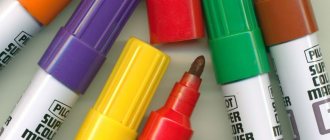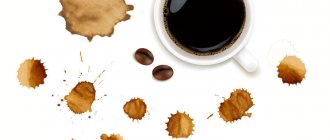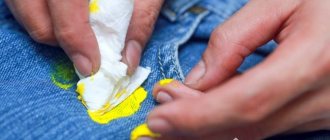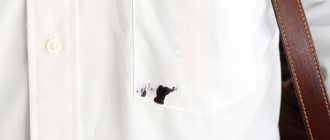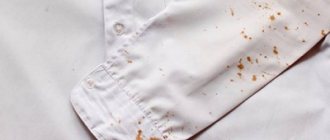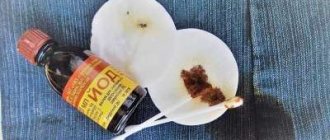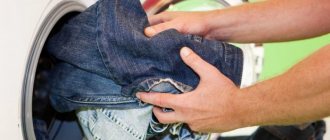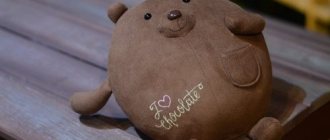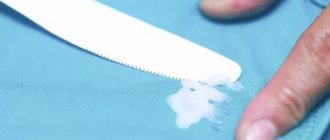The type of handle from which the contamination originated is also of great importance. It is usually easier to remove a mark from a ballpoint pen than to remove a stain from a gel pen, however, even in the latter case, you should not be upset, there are many means that will help restore your favorite thing to its original appearance.
Removing fresh stains from clothes
Pen stains should be removed from clothes, especially white ones, immediately. If you have a good stain remover at hand at home, you should use it as quickly as possible. The fact is that ink, especially from a black pen, instantly penetrates the fibers of the fabric, and then stains become difficult to remove.
Use stain removers according to the instructions. Usually it is enough to dissolve a cap of the product or 30 g in warm water or add the composition to the machine when washing. But what to do, and how to wash handles from colored and white clothes using improvised means, if it is not possible to use household chemicals?
Removing stains using improvised means. The first thing you can do is to erase unsightly marks in 72% brown laundry soap. First, grate a little soap and then dissolve it in a couple of liters of warm water.
The product is soaked in the resulting soap solution for 15 minutes. Then the stained area is washed by hand. The marks should go away. But this option will only help if the drawings are completely fresh.
You can try to save your clothes with sour milk. If the ink drawings are already old, then you will have to soak the clothes in warm sour milk for several hours, or best of all, overnight. When the milk turns dark, it will need to be replaced with new milk. If you don’t have sour milk on hand, and the stain urgently needs to be removed, you can use fresh milk. For greater effect, add a couple of teaspoons of lemon juice to the milk for soaking laundry.
Turpentine helps to cope with stains of various origins. He is able to remove traces of a gel pen even from white linen. The product is simply dripped onto the ink drawings, and then literally after a few minutes the item is washed in powder.
How to remove stains depending on the type of fabric
To remove gel pen ink without ruining your clothes, you need to choose a product suitable for the type of fabric. For delicate fabrics such as linen, silk and wool, it is necessary to select the most gentle cleaners. Otherwise, the trousers or T-shirt may become deformed and damaged, and the product may also burn through the fabric.
Mustard pulp, pre-diluted with water, is excellent for such materials. The mustard mass is applied to the contaminated area for 20-30 minutes, after which the contaminated area is washed off.
As you know, suede does not tolerate contact with water. How then to remove ink stains? You need to drop a couple of drops of valerian tincture and rub them over all problem areas. Then wipe dry with a clean cloth or paper towel. Valerian can also be used when cleaning dermantine or raincoat fabrics.
Salt is great for cleaning leather items from such contaminants. Salt must be mixed with warm water until a thick mass is formed. The resulting paste is applied to the area of contamination and left until completely dry. Afterwards, the salt is removed and the area is wiped with a dry cloth. The product can also be used to clean leatherette clothing.
If ink gets on your clothes, then regardless of the type of material, the item must be washed as soon as possible. Otherwise, the paint will be deeply absorbed into the fibers of the fabric. To slow down the process, you can fill the area with warm Vaseline or paraffin, and when you have time to wash the clothes in any convenient way. You can remove Vaseline or paraffin from clothing by ironing the item through a paper towel.
Removing old stains
But the methods listed will only help if the stains on the fabric are completely fresh. What to do and how to remove old stains that are well absorbed into the fabric?
A mixture of ethyl alcohol and ordinary table vinegar will help remove even very old “arts”. It is necessary to mix the two products in equal parts, and then pour the solution onto the stained area. After 10-15 minutes, the marks will fade and then disappear completely. All that remains is to wash the item with powder.
Baking soda will help remove gel pen stains on white and colored clothes. First, prepare the gruel by mixing soda with plain cold water. After this paste, lubricate the contaminated area and leave the product for 20 minutes. All that remains is to rinse the item and wash it with soap or powder.
Hydrogen peroxide is great for removing ink stains from white laundry. To prepare a cleaning solution, you need to combine equal parts of hydrogen peroxide and ammonia. The solution is poured over the stained area. You can also use a cotton pad. In just a few minutes, the stains will disappear, and all that remains is to wash the laundry. This method is only suitable for white fabric, since peroxide and ammonia bleach a little.
Hot lemon juice is another effective and inexpensive home remedy that can be used to remove gel paste effortlessly. This method works well to remove stains from thick fabrics, such as jeans.
To do this, you need to squeeze the juice from one fruit and heat it in the microwave. Hot juice is poured over the stain, and then the item is washed in an automatic washing machine.
A very effective product is dishwashing gel. It is enough to dissolve 2-3 tbsp. l. product in a couple of liters of water and wash the product. The product is especially good at removing pen marks from thick fabrics, but is not suitable for colored laundry.
Differences in color
Considering the ability of some folk or specialized products to bleach or, conversely, to tint, you should definitely take this fact into account when cleaning things.
White clothes
On light-colored material, traces from the gel rod are visible most clearly and seem absolutely irremovable, but on the contrary, it is for the most part easier to remove stains from white fabrics than from colored clothes. Most products contain bleaching agents, which in the case of these fabrics is only a plus. Stains on white can be removed using fermented milk products, hydrogen peroxide, special Antipyatin soap, as well as bleach and liquid stain removers.
Colored clothes
It is a little more difficult to work with clothes in bright colors or fabrics with colored patterns; there is a high probability of changing the tone of the paint or completely discoloring the area with the stain. In this case, even if the proportion of the solution of the same substances is changed, it is necessary to test on the reverse side of an inconspicuous place of the product and check the color reaction to the product. For such purposes, alcohol-containing substances or pure alcohol, soda, lemon juice and dishwashing detergent are perfect.
We wash the handle in an automatic machine
It is best to remove stains with special cleaning agents rather than putting the entire item in the washing machine. But it happens that the housewife simply loads things into the machine, hoping that the machine will remove all the stains. Is it possible to do this?
When washing in a machine, you should consider the type of fabric. Be sure to read the label on the product; it is possible that machine washing is prohibited. If you do choose to machine wash, you should add a stain remover to the tray along with the powder. Usually, 30-40 g of product mixed with powder is enough to wash things in the machine.
And, of course, you cannot wash heavily soiled laundry together with clean, especially white, as things may turn gray after the first wash.
How to wash colored clothes
When removing stains from colored clothing, the main thing is not to overdo it. Otherwise, the paint will fade and permanent stains will remain.
Unlike white items, colored items can be removed from ink with alcohol. The liquid must be applied to a cotton pad and left on the contaminated area for 5-10 minutes. When the ink becomes paler, it’s time to wash the item.
Dish detergent is also used to get rid of such stains. It is enough to soak the item for several hours in water diluted with 3 tablespoons of detergent. Then it is recommended to wash the item by hand in cool water.
You can also use some of the above products to clean colored items: brown soap, lemon juice, mustard and soda.
Don’t write off the item for scrap if you notice several such stains. Using the methods listed above, you can save not only clothes, but also funds.
Capricious fabrics
For delicate fabrics, such as natural silk or pure wool, cashmere, there are homemade recipes for removing stains that will never ruin the thread.
Silk fabrics can be cleaned of traces of the handle with mustard powder. The dry powder is diluted in half with water, and then the paste is applied directly to the stained area. When the composition dries, the product is washed in a suitable detergent.
Suede and leather do not tolerate contact with water, so ink cannot be washed off on them. Try wiping the stained areas with an alcohol solution of valerian. A cotton pad is soaked in the preparation, and then all the drawings are wiped off with it. The procedure is repeated until all the dirt is gone.
Table salt can also be used to cleanse natural leather. The salt is soaked a little with plain water, and then applied to the marks of the pen. After a couple of days, the salt is removed and the treated area is wiped with a damp cloth.
Cashmere and wool can be washed in an oxygen stain remover or you can use ordinary tar or baby bath soap. The stained area is rubbed with soap and the item is left for a couple of hours. After processing carefully, the ink is washed off with a toothbrush, and the item is completely erased.
Why does a gel pen leave marks?
School and office supplies for writing appeared relatively recently. A gel pen follows the characteristic structure of a ballpoint pen, but at the same time has fundamental differences.
The writing unit is equipped with a ball, which is hidden in a cone. The flow of ink begins automatically after the ball begins to rotate. A thin layer of dye envelops the ball and flows out, leaving marks on paper and other things.
Gel-based ink has a very dense, opaque structure. The dye contains copper phthalocyanine and iron oxides. The water-based gel also includes biopolymers (xanthan gum and gum tragacanth) and thickeners.
The coloring composition of the ink may contain large particles of mother-of-pearl, glitter and metallic dyes.
Among pens with gel filler, there are anti-fraud inks. Neither bleaches nor solvents take them.
There is also waterproof ink that can be washed off with water only before it dries. Next, you will have to use only chemical stain removal methods.
Useful tips
If this is your first time using a cleaning product, it is advisable to test it on an inconspicuous area of the product. This could be an inner seam or a place under the collar. If, a couple of hours after applying the product, you see that the fabric is not damaged, then the composition can be used to wash the entire item.
It is advisable to remove stains from a gel pen quickly, before the ink is deeply absorbed into the fibers of the material. The faster you start washing designs, the more likely you are to salvage a favorite item or wash a white shirt white.
Traces of a gel pen on white or colored linen are not a reason to throw away good things. Shirts, T-shirts, blouses and even jeans can be easily washed using simple household products.
What is important to know
First of all, you need to remember a number of important nuances:
- Pastes for gel pens are alcohol-soluble and water-soluble. You need to try different methods: if you can’t wash it with water, use an alcohol-containing solution.
- You need to remove ink marks in cold water, since hot water will only “weld” them to the material.
- To prevent the stain from spreading, you need to limit it on all sides with melted paraffin. You can remove paraffin at the end of the procedure with an iron. To do this, place paper napkins (or a towel) on the bottom and top of the item being treated and iron the fabric.
- Remember that it is better to start cleaning from the less noticeable underside.
General recommendations
There are a number of rules that must be followed if you want to restore an ink-stained item:
- You need to act quickly. Do not leave or delay washing a soiled item. Soak it immediately or use your chosen products to clean the stain.
- Do not remove stains mechanically. There is no need to try to blot it with a napkin or cotton pad, rub it off or scrape it off with a sharp object. This will only damage the fabric and speed up the process of ink absorption into its fibers.
- When treating a contaminated area, place a thick pad under it in the form of cotton fabric or a sheet of paper. This way you won't stain the back of the item, which remains clean.
- When choosing solvents and chemicals, be sure to consider the composition and type of fabric being treated. Don't forget that your main goal is to return your favorite item to its original condition without damaging it.
- When using aggressive agents and solvents, protect your respiratory system and hands by wearing thick rubber gloves.
Wallpaper Rescue
It doesn't cost kids anything to leave their wonderful creations on the wallpaper. Even if you just made repairs yesterday. You can get rid of “rock painting” like this:
Don't forget about glycerin
Remove pen from wallpaper? Easily!
Preparing for cleaning
Before you wash your gel pen from your clothes, pay attention to the following. Unlike stains from the ink of a ballpoint pen, blots from it can spread on a large scale during cleaning. Therefore, the first step is to outline the contours of the area where you will perform life-saving manipulations:
- 1. You will need either paraffin or wax. Heat the substance in a water bath.
- 2. Using a cotton swab, dipped into paraffin from time to time, outline a clear closed contour.
- 3. Make sure that the wax saturates the fabric through and through - you should not perform any procedures before this.
- 4. Once you have removed the stain, scrape off the wax or paraffin line and wash the item completely.
Unexpected but effective
Advice! All proposed manipulations are for large-scale pollution. You shouldn’t waste a lot of time on a small blemish - you can deal with it by rubbing it with an old toothbrush and laundry soap.
How to remove ink from a white shirt or other clothes
Even though every year we write less and less with pens, preferring a computer keyboard, there are situations when we cannot do without a good old ballpoint pen. For example, at school during a lesson. And now your student comes with a huge blot on a white shirt or sweater. Before we start removing the stain, let's decide on the fabric with which we will remove the stain.
Status fountain pens have the unpleasant property of leaking and staining light-colored things with ink.
There are actually many ways to remove ink stains from white clothes. To choose the right method, you need to determine what material the product is made of. Its composition is indicated on the label.
- Cotton and linen allow the use of laundry soap, ammonia and ethyl alcohol, hydrogen peroxide, baking soda, acetone, gasoline, milk, acetic and citric acid. Old stains on these fabrics can be removed with oxygen stain removers, as well as bleaches containing chlorine (Domestos, Belizna).
- For white silk and wool, lemon juice with salt, glycerin, and milk are suitable.
- Synthetics can be washed with laundry soap. Here it will wash away even old stains. However, the use of alcohol is not prohibited; they will not cause harm to the products.
- For leather (natural and artificial), glycerin, foam cleanser, shaving or hand cream, as well as hairspray or antistatic spray are suitable.
- Suede from liquid ink can be blotted with talcum powder, chalk or baby powder, but it is better to wipe off the remaining traces with special cleaners or, at worst, with a soap solution
- Whitening toothpaste can be used on any light-colored fabric.
You should know that ink is usually water-soluble, while ballpoint pen paste is alcohol-soluble.
Rapid Response: Where to Start
The sooner you start removing the stain, the greater the likelihood of it disappearing without a trace. However, before you remove a stain from a ballpoint or gel pen, you need to prevent it from expanding. For this:
- Place a thick napkin on the inside of the stained area. This will prevent ink from bleeding onto the other side of the product.
- Using melted wax, follow the contour of the stain. This way the pollution will not increase.
- Sprinkling the stain with talc, starch or chalk will help keep the ink on the surface of the fabric.
What should you not do when cleaning pen stains?
If you want to remove stains, do not do the following:
- Do not rub the stain or try to blot excess paste with a napkin. Pressing the stained fabric will only lead to faster absorption of the ink, which will make it more difficult to get rid of later.
- Do not treat the stain without placing a sheet of paper or a piece of thick fabric under it. Otherwise, the ink will print on the other side of the item, and you will have to clean two spots.
- Do not apply harsh solvents directly to the contaminated area. Pre-test the product on an inconspicuous area of fabric, and only then use it to clean the stain.
- Do not try to get rid of the stain mechanically. To clean rough and dense fabrics from paste and ink, many recommend simply rubbing the stained fabric with sandpaper or scraping it with a sharp object. Under no circumstances should you do this unless you want to say goodbye to the item being processed.
How to remove ink using folk recipes?
The table below presents the most effective means for removing gel pen marks from fabrics:
| Means | What types of fabric is it suitable for? | Application and features |
| Hot milk | For natural fabrics | Heat to 90 °C, apply to the contaminated area. Leave for 20 minutes, rinse. |
| Paraffin | For any fabrics | Melt and drip dirt around the edges. It will help to mark the boundaries of the spots. Will not allow the ink to smudge. |
| Talc | For any fabrics | Pour in and let the ink soak in. Shake off any remaining residue. Prevents ink from bleeding. |
| Baking soda | For delicate fabrics | Add 1 tbsp to 100 ml of cool water. l. sodium bicarbonate. Rub onto the stain and leave for 30 minutes. |
| Mustard powder | For delicate fabrics | Dilute with water. Apply the substance and leave until dry. Clean off frozen mustard. |
| Hair fixation spray | For natural fabrics | Spray onto dirt. Wait until the ink disappears. |
| Solvents with acetone | For natural fabrics | Apply the composition, leave for 10 minutes, rinse. Using this liquid, you can destroy any contaminants, but potent compounds damage delicate fabrics, leaving marks. |
| Lemon juice | For delicate fabrics | Squeeze the juice onto the blot and wait 60 minutes. Rinse. |
| Turpentine and ammonia | For natural fabrics | Combine ingredients (1:1). Apply the composition. |
| Micellar water | For delicate fabrics | Soak a cotton pad in a cosmetic product and wipe the blot. |
| Shaving foam | For any fabrics | Apply the composition, wait 4 hours. You cannot rub the blot, as the ink will penetrate even deeper into the fabric. |
| Nail polish remover | For natural fabrics | Moisten a bandage or cotton pad and treat the ink stain. Rub the material with little effort. |
| Gasoline and fine sawdust | For natural fabrics | Soak the cloth in gasoline. Sprinkle the blot with a thin layer of sawdust. Allow the material to dry, shake off any remaining loose material. |
| Hand cream | For any fabrics | Spread thickly. Wait until the product is absorbed into the material. Remove residues with a damp cloth or napkin. Only fatty formulations are suitable. |
| Toothpaste | For any fabrics | Rub the paste into the ink using massaging movements. It is better to choose white formulations, since colored ones wash off less easily. |
Effective ways
It is very unpleasant to find traces of a gel pen on your favorite clothes, which can easily leak or scratch on the fabric. Most often, such stains on things are found among schoolchildren, students, and office workers. Looking at the terrible dark stain, it seems to us that it is simply impossible to remove it from the fabric. In fact, there are a large number of ways to help clean gel pen ink stains.
Please note that the sooner traces of contamination are detected, the easier it will be to remove them. This rule applies to almost all types of pollution.
What effective methods currently exist:
- One of the simplest and most effective ways to help remove these types of stains is to use dishwashing liquid. The liquid composition copes well not only with fat, but also with the coloring pigment of gel ink. To remove it, simply moisten the stained area with water, apply the composition to it, and then gently rub the fabric until a characteristic foam forms. After washing in dishwashing liquid, clothes should be rinsed and dried.
- The following recipe involves using baking soda and ammonia. To remove ink stains from a gel pen, just moisten the contaminated area with ammonia, then apply baking soda to it and pour the alcohol over it again. Lightly rub the resulting mixture over the fabric and wait a couple of minutes before removing. Further rinsing will help remove any remaining cleaning products.
- Vinegar can help remove such stains, but you should be careful with colored items, as vinegar causes them to shed. Test the product on an inconspicuous place, and then calmly remove stains.
Gel pens write well, which is why they are popular
- There is a good recipe using glycerin. You need to create a solution based on it by mixing it with water. Soak soiled items in this mixture for an hour and then rinse them in lightly salted water. After rinsing, we carry out a normal wash, which allows you to completely remove any remaining dirt.
- Glycerin is also involved in another recipe, where it is paired with ethyl alcohol. These components should be mixed in equal proportions, then heated in a water bath (flammable materials do not heat up over an open fire), and then applied to ink marks, treating unpleasant stains. Further washing with detergent or soap will remove any remaining ink and cleaning solution.
- Old stains are always very difficult to remove, but with fresh ones the fight can be quick. To defeat ink you will need salt and lemon juice. Salt is poured directly onto the ink stains, and then lemon juice is poured on top. After waiting for some time, the cleaning agents are removed along with the dirt. If you don't have salt on hand, you can use lemon juice alone, but you will need more. Having treated the stain generously, you need to wait a little and then rinse everything off with regular warm tap water.
- For white items, use hydrogen peroxide or ammonia. These compounds are mixed with water in the proportion of 1 teaspoon of cleaning product to 1 glass of clean water. The resulting composition should be used to treat unpleasant stains and then wash the clothes.
- You can try cleaning your clothes with turpentine. Turpentine is a fairly loyal composition for many types of fabric. Just soak a cotton pad in it and gently treat the stained area. Remaining dirt and turpentine can be removed by subsequent washing in lukewarm water.
Modern hardware stores sell special products for removing stains of this kind. Of course, you will have to spend a little money to buy them, but following the instructions you can easily remove traces of ink from your things. According to housewives with wholesale, Antipyatin gel or soap works great to wash off ink stains.
